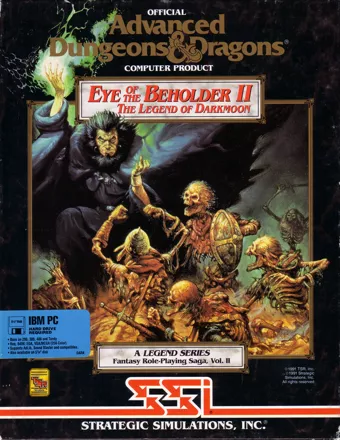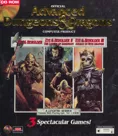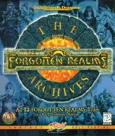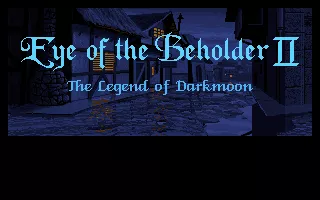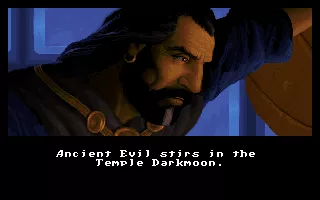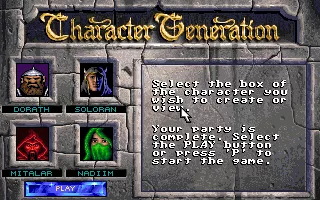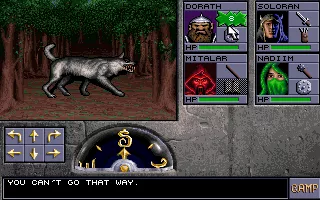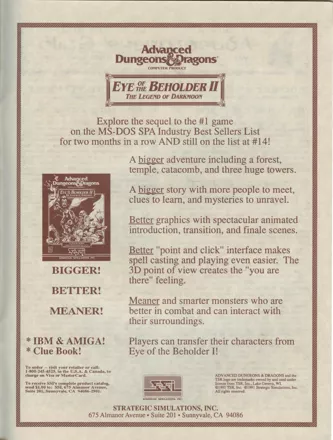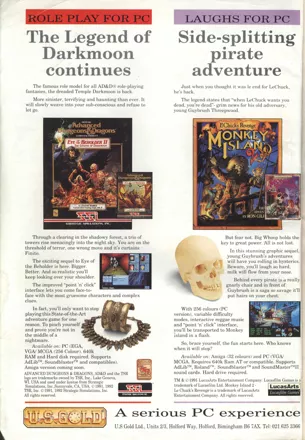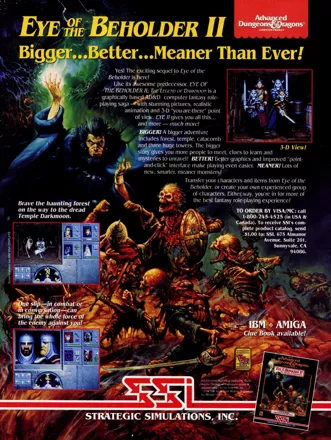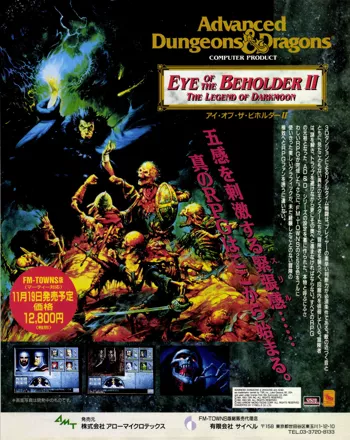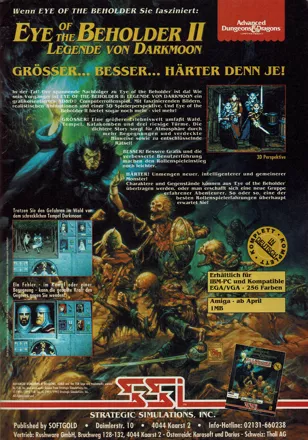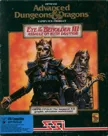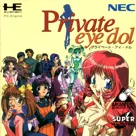Eye of the Beholder II: The Legend of Darkmoon
Description official descriptions
The Archmage Khelben summons the Heroes of Waterdeep, slayers of the Beholder Xanathar, for another mission. Strange things are happening in the forests near Waterdeep, centered around the Temple Darkmoon. People have been disappearing and shallow graves containing human remains have been found. Khelben teleports the party to the forests near Darkmoon so they may find out what kind of evil is working in the towers of the temple.
Eye of the Beholder II: The Legend of Darkmoon is, like its predecessor, a first-person dungeon-crawling role-playing game based on the second edition of AD&D rules. It uses the same point-and-click gameplay mechanics and controls as the first game, with only minor changes. The game is set entirely in pseudo-3D maze-like areas; no automapping is available. Combat flows in real time, and characters can move as a single unit to lure enemies or avoid blows.
A starting party consists of four characters, which can be transferred from the earlier game or created from scratch. Six classes (Fighter, Ranger, Paladin, Cleric, Mage, and Thief) are available. Characters can reach higher levels and learn new spells, must face new and tough monsters, and solve multiple puzzles. Compared to the first game, many more illustrated NPC encounters and cutscenes were added.
Spellings
- アイ・オブ・ザ・ビホルダーII - Japanese spelling
Groups +
- Dungeons & Dragons (D&D / AD&D) licensees
- Dungeons & Dragons Campaign Setting: Forgotten Realms
- Eye of the Beholder series
- Fantasy creatures: Dragons
- Fantasy creatures: Dwarves
- Fantasy creatures: Elves
- Fantasy creatures: Gnomes
- Fantasy creatures: Halflings / Hobbits
- Gameplay feature: Character development - Automatic leveling
- Gameplay feature: Hunger / Thirst
- Gameplay feature: Importable characters
- Games with manual lookup copy protection
- Genre: Dungeon crawler
- Protagonist: Female (option)
Screenshots
Promos
Credits (DOS version)
60 People (53 developers, 7 thanks) · View all
| Producer | |
| Playtesting | |
| Level & Manual Translation | |
| Set in German Manual |
|
| Special Thanks To | |
| Design | |
| Lead Programming | |
| Music | |
| Original Concept | |
| Sound | |
| Intro & Finale by | |
| Art & Graphics | |
| Writer | |
| Special Thanks |
|
| [ full credits ] | |
Reviews
Critics
Average score: 86% (based on 26 ratings)
Players
Average score: 4.0 out of 5 (based on 91 ratings with 5 reviews)
The Good
Legend of Darkmoon was probably the first computer roleplaying game that graphically told a story. While other rpg's had storylines there where often nothing more than a prelude and a prologue and a great deal of hacking in between. Others had a continuing storyline, but it was just text, no visuals to support it.
LoD starts with an animated introduction, as you progress you encounter NPC's that only adds to the mystery around the old temple Darkmoon. Even further you encounter notes staggered around, telling you more about the truth. You also experience several cutscenes about whats happening inside and outside of the temple as your adventure continues towards the at-the-time original ending.
Besides the storyline, Legend of Darkmoon was also the first rpg that was actually put into a crafted location. It doesnt take place in this humongous dungeon, or forest, or whatever. It all takes place in a huge temple with a underground system and three tall towers.
It is also one of the first rpg's that isnt entirely linear. You will travel downwards or upwards, and each new thing you find might be your key to unlock a new part of the temple.
Today the graphics is a bit dated, but if you can ignore the fact that the game is ten years old, you will love it. Its one of the few games from this time that is worth a try.
The Bad
Its difficult alright. I played the game with a party imported from Eye of the Beholder 1, and I really cannot see anyone having an easy time with fresh new characters. Some of the puzzles are really difficult and it does require a whole lot of thought, or a walkthrough, to finish it.
Also, there is one part of the game that can only be passed if you have an thief in your party. There is a thief you may recruit, but if you dont do it right, you might be stuck and forced to restart the entire game.
The Bottom Line
History about the game:
Back in 1986, Dungeon Master revolutionized the role-playing genre as it was the first real time computer rpg game with a 3D view and mouse control. Other companies where not late with trying to copy the success of Dungeon Master.
One such company where Westwood Associates and their Dungeon & Dragons licensed game "Eye of the Beholder".
Even if "Eye of the Beholder" blasted the competition out in the orbit, it was still 'only' a classic dungeon hack. The Sequel, "Legend of Darkmoon" released in 1991, raised the bar of role-playing games, forever.
Where Eye of the Beholder lacked in story, Legend of Darkmoon had a rich and intriguing storyline, from start to end.
Story: The heroes of Waterdeep are sent to investigate strange disappearances from villages north of the city. Reports have been made of discoveries of human remains in shallow graves. The clues seem to lead to the Temple Darkmoon, which appears to be a peaceful sanctuary, run by divinely-inspired priests. Alas, as often happens, appearances are deceiving, and the TempleÂ’s dark secret is up to the players to unfold.
DOS · by JemyM (6) · 2024
The Good
The story is simple, but a step up from the previous game.
Exploring the dungeons is a lot of fun and there's a strange sado-masochistic sort of joy in not having an automap. I really enjoyed mapping it out on gridpaper. There were too many parts where the walls would keep moving or the player would be randomly teleported, though.
The Bad
Some parts of the game are extremely difficult, including a part near the start.
The combat is as bad and annoying as in its predecessor.
Despite the Dungeons & Dragons core of the game, the game lacked a distinct sense of progression. Characters didn't really feel like they were getting more powerful and there wasn't a lot of interesting items to be found.
The Bottom Line
Most of The Legends of Darkmoon doesn't really step away from its predecessor. The story is a bit better, you get some outdoor parts (which are still gridlike blocks), but nothing revolutionary. So worthwhile only if you liked the first game in the series.
DOS · by vedder (75617) · 2024
Extremely challenging, and extremely good.
The Good
Eye of the Beholder II is one of the classic CRPGs that set the standards for years to come. I have been trying to complete this game for over ten years now - ever since I first played it, and without success... until today. This goes to prove two things: the first is that EOB2 is an incredibly good game, and the second is that EOB2 is an incredibly tough game to beat.
So what's so good about it? The first thing that comes to mind is the brilliant graphics. Between the great 2D drawings that are so very typical of Westwood (as is clearly evident in The Legend of Kyrandia, for instance) and the very detailed psuedo-3D engine, the game really looks gorgeous; not having real freedom of movement - remember this game came out a full year before what I believe is the first realtime raycasted shooter, Catacomb Abyss - means that the artists had much more freedom than usual creating very detailed textures and sprites.
The interface is great - it is easy to learn and easy to manage. It is not perfect - some things could have been done better, for example the ability to see the compass and cast a spell at the same time, or being able to see character statistics at the same time as changing items (so one can see the immediate influence of the items), but despite these shortcomings the interface is extremely well designed and makes even intense battles easy to manage.
The music in the PC version is not as good as the Amiga version (despite having more sound channels) for obvious reasons, but it is still terrific, having being made by Frank Klepacki (later to make the music for both Dune 2 and Kyrandia).
The story is not particularly deep, but is very characteristic of the D&D or AD&D adventures that were commonly sold when these gaming systems were prevalent.
Finally, gameplay is extremely long (even someone deeply familiar with the game will probably need a few days to finish it), the environments are varied and the game is very satisfying over all.
The Bad
Like I said before, Eye of the Beholder II is incredibly difficult - occasionally ridiculously so. Some battles require dozens of reloads, and on occasion I just couldn't figure out a puzzle and had to use a walkthrough (I wish I could say this happened only once...). Kudos to anyone who's managed to finish the game without any outside help.
The Bottom Line
An incredible game, worthy of the title "An Advanced Dungeons & Dragons 2nd edition computer product".
DOS · by Tomer Gabel (4534) · 2002
Discussion
| Subject | By | Date |
|---|---|---|
| Third time's the charm? | vedder (75617) | Jun 25, 2010 |
Trivia
Awards
- Amiga Joker
- Issue 02/1993 – #2 Best RPG of 1992 (Readers' Vote)
Analytics
Related Sites +
-
Eye of the Beholder 2 Walkthrough
on gamewinners.com -
Legend of Darkmoon - FAQs & Guides
posted on GameFaqs.com -
The All-Seeing Eye
An automapper for the DOS versions of the first two Eye of the Beholder
Identifiers +
Contribute
Are you familiar with this game? Help document and preserve this entry in video game history! If your contribution is approved, you will earn points and be credited as a contributor.
Contributors to this Entry
Game added by Tomer Gabel.
FM Towns added by Terok Nor. PC-98 added by Unicorn Lynx. Amiga added by MAT.
Additional contributors: Jeanne, JRK, Patrick Bregger, Azif Kylander, Skippy_Chipskunk.
Game added October 9, 1999. Last modified September 23, 2024.


